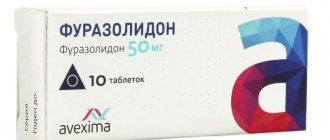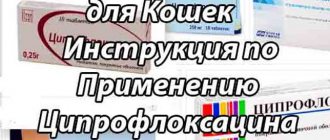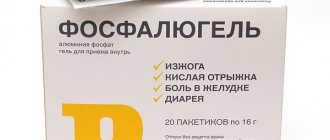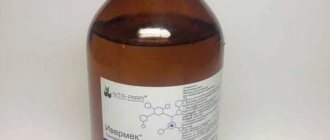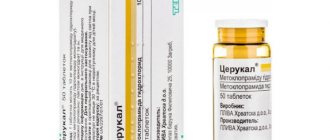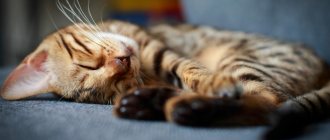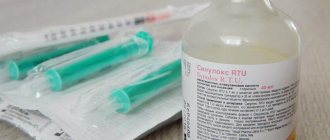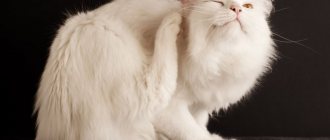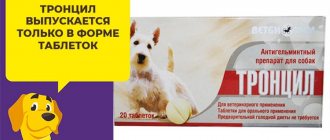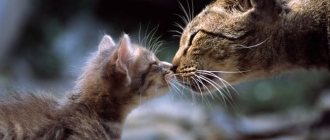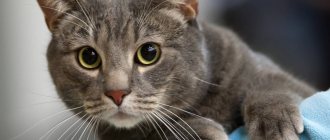6865Pavel
Many breeders are in no hurry to contact qualified veterinary clinic specialists at the first signs of diarrhea in their pet, preferring to self-medicate. After all, the famous Furazolidone for cats often becomes a real salvation in such a situation. However, diarrhea in your beloved pet clearly indicates a disruption in the digestive tract. It is a mistake to assume that with such an illness the cat is completely safe and its condition is not critical.
Causes, types and diagnosis of diarrhea in cats
Treatment of any ailment is quick and successful if the owner understands the cause of the problem. Diarrhea is a very common symptom of many conditions, so figuring out its cause can be difficult.
The main ones include:
- Poor quality, spoiled, fatty food.
- Worm infestation.
- Infection, virus or bacterial infection.
- Foreign body.
- Swallowing bones.
- Stress.
For proper therapy, it is necessary to distinguish between forms of diarrhea . The fact is that the more severe the diarrhea, the more severe the dehydration. The urgency and “severity” of the measures taken will vary, depending on the form of manifestation of the disease:
- Acute – started abruptly and continues.
- Chronic – the condition lasts for more than 3-4 days.
- Recurrent – the disease recurs periodically.
For a correct diagnosis, it is necessary to collect an anamnesis, measure the cat’s body temperature, and, if necessary, examine the animal for injuries and pathologies of internal organs. You need to understand that most very serious illnesses begin with a slight malaise, diarrhea and vomiting.
This is interesting: The cat often licks itself
Causes of diarrhea in a kitten
Diarrhea cannot be considered a safe condition, since the body quickly loses fluid, which threatens dehydration.
Following dehydration, metabolic disorders and blood thickening occur, which leads to increased stress on the heart. Diarrhea is considered not dangerous, or rather, not severe, if it occurs no more than 2-3 times during the day and lasts no more than a day. The body can cope with such fluid losses if the kitten is provided with drink. If the situation looks more serious, the pet needs treatment. All therapeutic actions will have the expected result only if the owner managed to identify the cause of the disease as accurately as possible.
https://www.youtube.com/watch?v=LWGAlT3exOo
A kitten that has recently arrived at home may develop diarrhea due to:
- A sudden change in nutrition - if you buy a kitten during the adaptation period, you need to feed it with its usual food and according to an established schedule. If you pick up a baby on the street, a slight digestive upset cannot be avoided. If you don’t know what your pet ate during the first days, try to feed it neutrally.
- Worm infestation is an especially common case if the baby was taken from the street.
- Viral, infectious, bacterial disease - small kittens are vulnerable to most infections. If the baby is cold, has not slept for a long time, or has not eaten well, his immunity will weaken.
- Eating spoiled food and bones – applies to kittens picked up from the street or having free access to a walk.
- Stress is very likely to cause diarrhea if you recently got a kitten. The cause of stress can be another pet, punishment, the arrival of guests, moving, excessively active games, lack of sleep, regular overeating, blood-sucking parasites, bathing and much more.
Treatment methods differ depending on the type of diarrhea, its duration and the condition of the pet:
- In case of acute diarrhea, treatment is carried out with shock, but not long-term.
- The chronic form depletes the body, so gentle and supportive therapy is used.
- Diarrhea that goes away and disappears on its own indicates a systemic disorder, but the cause may be related not only to health, but also to care.
Before treating a kitten, especially without a doctor’s prescription, be sure to analyze the situation. Measure the temperature; if it is elevated, it is not diarrhea that needs to be treated, but most likely a virus or infection. Take an anamnesis and inspect the home; perhaps the kitten swallowed a thread, a piece of oilcloth, or stole something from the trash can. Again, in this case, treatment of diarrhea is disastrous; it will lead to the loss of invaluable time and blurring of the clinical picture.
Usually, if we are talking about a virus, infection or pathology, in addition to diarrhea, the kitten experiences vomiting, changes in body temperature, refusal to eat and apathy.
Dosage and method of administration
The product is produced in the form of yellow tablets. Furazolidone is given to cats in crushed form for diarrhea. It is forbidden to put a whole tablet into a cat's mouth, as the pet may choke. It is recommended to grind the drug to a powder, mix with a small amount of plain water and use a syringe without a needle to inject into the animal’s mouth. Some livestock breeders recommend applying the solution to the pet's nose. In cats, this manipulation causes reflex licking. Thus, the sick cat licks the liquid along with the medicine.
The dosage of Furazolidone for cats depends on the size of the sick individual. Adult cats weighing more than 5 kg per day are allowed no more than one tablet. The tablet is divided into 3 parts and crushed. After mixing a third of the tablet with water, it is given at intervals of 4 hours. For small breeds, half the tablet is divided into three parts. For diarrhea, it is better not to use Furazolidone for cats weighing less than 2 kg. If you still cannot do without treatment with this drug, then the dosage should be 1/6 of the tablet. That is, the tablet should be divided into 6 parts and given one part at an interval of 4 hours. The course of treatment with medication is usually 7 days.
An overdose of the drug can provoke convulsions and vomiting. If you notice such side effects, immediately call a veterinarian or give your animal a gastric lavage. Among the disadvantages of the medication, I would also like to note the effect on the beneficial intestinal microflora. Like all antibacterial drugs, it can wash out beneficial bacteria and cause dysbiosis. That is why it is recommended to use it together with probiotics such as Lactiale, Linex or Bifidumbacterin.
If you are faced with symptoms of diarrhea and all your efforts to treat your pet at home have not yielded results, it is better not to waste time and contact a specialist. Furazolidone will not help a cat with diarrhea if diarrhea is not a separate disease, but, for example, a symptom of an oncological tumor, canine distemper, jaundice, a form of rabies, as well as fungal infections of internal organs. In these situations, competent complex therapy, and sometimes even surgical intervention, is necessary. Remember that inept use of Furazolidone can cause significant harm to the animal’s body and even cause death.
Symptoms of diarrhea in cats and cats
Before we talk about symptoms, you need to find out what causes the problem with diarrhea. Perhaps the reason for this was infectious diseases of the intestinal tract, an incorrectly selected diet, long-term use of antibiotics, inappropriate food, a sudden change in menu, helminthic infestation, intoxication or inappropriate medicine, gastroenteritis.
By the way, there are breeds of cats in which any new dish can cause diarrhea. Such whims include the Canadian Sphynx and Devon Rex.
In addition to loose stools, there are other symptoms that paint the full picture:
depressed state of the animal;
weight loss with prolonged diarrhea;
loose stools; mucus, blood, and undigested food particles may be present in the stool;
If the cause of the disease is correctly identified, then appropriate treatment will give an excellent result. To do this, the veterinarian must hear all the information regarding the cat’s behavior within a few days. During the examination, the temperature will be measured, the abdomen will be palpated, and the degree of dehydration will be determined. The clinic will definitely take a stool and urine test and examine the feces for hidden bleeding. If necessary, an x-ray is prescribed - this will help ensure that the animal does not suffer from intestinal obstruction, peritonitis and pancreatitis.
Duration of diarrhea
Diarrhea in a cat sometimes occurs suddenly, and it can go away just as suddenly. If the case of diarrhea is isolated, then there is little reason to worry. It should become alarming when loose stools continue for more than two days in a row.
There are conditionally three groups of duration of diarrhea in cats and kittens:
acute: duration is several days;
chronic: the animal suffers from diarrhea for more than 7 days;
intermittent: loose stools return within a month.
Diarrhea in cats due to improper nutrition can be treated quickly by eliminating the cause. The intestinal disorder passes, and the functioning of the digestive system returns to normal. A starvation diet for a couple of days in this case is a worthy measure; along with it, in the first hours of diarrhea, the animal is given less water. Other types of intestinal tract disorders require more attention.
Application, overdose, interaction
Furazolidone is recommended for many infectious diseases:
- infectious gastrointestinal diseases: dysentery, cholera, food poisoning, infectious diarrhea, paratyphoid;
- for pyelitis, urethritis, cystitis;
- for parasitic diseases (giardiasis, trichomoniasis);
- for wounds, burns, frostbite.
Furazolidone is a dangerous drug that, in case of overdose, provokes the following syndromes:
- toxic hepatitis;
- nerve inflammation;
- allergies.
If there are symptoms of overdose, the drug is discontinued, antiallergic drugs and B vitamins are prescribed, and it is recommended to drink a lot of water.
The drug must be taken with caution, as there are several interactions:
- tetracycline antibiotics and aminoglycosides enhance the antibacterial effect of furazolidone;
- amphetamines, antidepressants, MAO inhibitors, tyramines, phenylephrines, ephedrines react with furazolidone and sharply increase blood pressure;
- when reacting with chloramphenicol or ristomycin, blood formation is blocked;
- cannot be taken with alcohol.
Remember! The drug has a negative effect on the fetus, miscarriages or genetic abnormalities are possible. Therefore, furazolidone is fed to pregnant cats only when absolutely necessary.
Treatment with Furazolidone
Furazolidone is a drug with a broad spectrum of action aimed at destroying germs and bacteria . Compared to similar drugs, the advantage of Furazolidone is that microorganisms slowly develop resistance to it. The price of the drug is quite modest, perhaps for this reason veterinarians are not very fond of prescribing it. At the same time, Furazolidone is more powerful than many well-known drugs and is often used if antibiotic treatment does not produce visible results.
Furazolidone is used to treat enteritis, hepatitis, coccidiosis and other diseases caused by microorganisms.
The drug is used in the treatment of almost all animals. For many years, furazolidone has been used to treat diarrhea in ruminants, poultry, pigs and small domestic animals - dogs and cats. Good results were obtained when the drug was used in the treatment of massive intestinal infections of the viral type . Naturally, in parallel with taking Furazolidone, additional therapy is carried out.
It is not entirely convenient that the drug is sold only in tablet form, although considering its purpose, this is quite logical. The small tablets are coated with yellow glaze and do not smell of anything, but have a bitter odor, so problems may arise when treating a cat. The tablet must either be crushed, dissolved in water and given to the cat to drink, or divided into pieces and forced to swallow. In both cases, your cat will feel bitter and you will most likely notice a lot of drooling.
Important! Furazolidone is not recommended for use without a doctor's prescription. The same applies to Levomycetin and Loperamide.
The dosage of Furazolidone is prescribed individually and only by a doctor. One tablet contains only 0.05 g of active ingredient, so you need to be careful when dividing it into parts. Practice shows that an overdose leads to a serious deterioration in the animal’s condition. Even the drug instructions do not contain detailed data on doses, only ranges and possible treatment algorithms. By the way, Furazolidone is rarely prescribed from the first day of therapy ; it is usually included in treatment if there is no positive dynamics.
Self-medication is very risky, but if you do not have any alternatives and the opportunity to consult a doctor, you need to use a regimen that can be called standard for cats:
- The drug is crushed in the required quantity and mixed with food or water.
- The resulting mixture is divided into 3 parts and force-fed/drinked to the cat every 4-6 hours.
- The dosage for a large (over 5 kg) cat is no more than 1 tablet per day. For small cats, half a tablet; for kittens, it is better not to use it.
Important! Furazolidone is strictly not recommended for the treatment of pregnant and lactating cats. The drug is not recommended for animals whose medical history is unknown, weakened animals, elderly four-legged animals, and cats in estrus.
Even if the drug was prescribed by a doctor, the cat’s condition must be monitored, since Furazolidone (like any medicine) has side effects. Rarely, some animals experience an allergic reaction , indicating intolerance to some of the components of the drug. The risk of side effects increases sharply if Furazolidone is used for a long time or in excessive doses.
The most dangerous consequences of improper treatment can be called toxic liver degeneration and lipoid degeneration of the kidneys, but for such a result the dose must be greatly exceeded. A rare side effect occurs in the form of polyneuritis - massive nerve damage.
Diarrhea in a pregnant cat
During pregnancy, a cat is susceptible to attack by viruses and bacteria. Any invasion of a microscopic enemy into a cat’s body can give rise to intestinal problems.
During pregnancy, you should not experiment with new food on the cat’s menu, as there is a chance of stumbling into an intolerance to some product. These can be dairy products, beef, horse meat, soy, fatty fish, chicken eggs.
The body of a pregnant cat can react with diarrhea even to previously easily digestible food.
If the cat always seems hungry when the feeding rate is appropriate, and the compassionate owner decides to feed her more, diarrhea may occur. A large amount of food is not digested, but quickly moves through the intestines in the form of liquid gruel.
Loose stools early in pregnancy can cause miscarriage. Two days before giving birth, diarrhea in your cat is normal and not something to worry about.
When is it used?
It is recommended to give Furazolidone tablets to cats for various infectious pathologies, including:
- cholera;
- dysentery;
- diarrhea of infectious etiology;
- inflammation of the mucous membranes of the renal pelvis, urethra, bladder;
- wounds, burns.
Broad-spectrum antibiotic.
This is interesting: Where is the cat's heart?
Application and dosage
There are many recommendations for dosage and treatment regimen depending on the disease, type and condition of the animal. For kittens with diarrhea, the daily dose is 15 mg/kg body weight - this is about a third of the tablet. In this case, the daily dose should be divided into at least 2 parts, given in the morning and evening. Therefore, the tablet should be divided into 6 parts, fed 1/6 tablet 2 times a day with a break of 6-8 hours.
Since the tablet is small and needs to be divided into 6 parts, it may happen that the tablet splits unevenly. To make dosages more accurate, it is recommended to crush the tablet to a powder. Next, on a sheet of white paper, you divide the resulting powder into 6 equal slides. Each resulting dose can be wrapped in a sheet of paper. One dose can be fed through a syringe by mixing the powder in water.
The cat has yellow diarrhea
Yellow diarrhea in a cat without signs of orange is considered normal, since bilirubin in bile is processed into brown stercobilin, and with loose stools, bilirubin may not be completely processed. But bright yellow or yellow-orange stools indicate jaundice or poor absorption of foods. Having analyzed the cat’s menu of the last few days, and noticing that there was a lot of milk, raw seafood, liver, and fatty meat, they urgently change the pet’s diet. If a half-starvation diet does not produce results, the cat is shown to a specialist.
How to treat
If the cause of yellow diarrhea in a cat is overfeeding or a reaction to new food, then you can do home treatment. But this can only be done if the cat’s condition does not cause concern. Home treatment consists of supervision - the cat’s condition must be kept under control, and the younger the pet, the more dangerous loose stools are. Dehydration can kill a kitten very quickly. Access to clean boiled water is required.
Since bilirubin is an aggressive substance, after each bowel movement you need to wash the dirty area around the anus with warm water and soap.
If yellow diarrhea is the result of overfeeding, then the cat is offered a tablespoon of pumpkin puree 2-3 times a day. You can use ready-made baby puree.
Negative consequences
During the course of treatment, cat owners need to monitor the condition of their pets, since, like any medication, Furazolidone can provoke unwanted reactions. In animals with intolerance to the components of the antibiotic, an allergy may manifest itself in the form of itching and rash on the outer cover of the cat’s body.
When using an antibacterial agent in excessive doses and for a long time, the risk of developing toxic liver dystrophy increases significantly. In addition, veterinarians emphasize that abuse of Furazolidone can lead to inflammation of the nerves.
Storage conditions
The success of the therapy depends on the correct conservation of the medication. Therefore, in order for Furazolidone to retain its high therapeutic activity until the end of its shelf life, which is 3 years, the tablets should be stored in a dry place away from sunlight at a room temperature of no more than 25 degrees Celsius.
Brief description: Furazolidone is a drug that belongs to the nitrofuran group and has extensive antimicrobial effects on gram-positive and gram-negative bacteria. The undoubted advantage of the drug is that microorganisms very slowly develop resistance to the substance, while it remains very insignificant.
Indications for the use of the drug are various diseases caused by bacterial infections, such as salmonellosis, colibacillosis, coccidiosis, balantidiasis, enteritis, hepatitis and others.
For whom: most often used in veterinary medicine for the prevention and treatment of infectious diseases of farm animals - cattle, pigs, poultry, as well as intestinal infections of dogs and cats.
Dispensing form: The drug is produced in the form of round tablets of yellow color, odorless, slightly bitter taste, with an active ingredient content of 0.05 g. Tablets are packaged in 10 pieces in contour cell-free or cell packaging, which, together with instructions for use of the product, 2 pieces are placed in a marked cardboard box.
Dosage: Depending on the type of animal and the type of disease, there are many individual treatment regimens with specifically selected dosages of the drug. It can only be prescribed by a veterinarian observing a sick animal.
The most common general regimen for the use of Furazolidone in livestock is as follows. The daily dose of the medicine must be mixed with food or water, divided into three equal parts and fed with an interval of 4-6 hours.
For gastrointestinal disorders in dogs and cats, the dosage of the substance depends on the weight of the animal. For example, for a large dog the daily norm is 0.15 g, which is divided into three doses (1 tablet 0.05 g three times a day).
Limitations: Side effects from Furazolidone may develop with long-term use in large doses. There may be cases of manifestations of such specific conditions as neuronephritis, toxic liver dystrophy, polyneuritis, and allergic reactions are possible. It is not recommended to use the drug on weakened animals in the spring.
The use of the medicine for pregnant animals is prohibited.
Reviews from veterinarians
I prescribe a nitrofuran drug for intestinal dysfunction. An exact dosage is necessary; Furazolidone helps cats get rid of Giardia and treats food poisoning in cats. After a course of therapy, the animal recovers. Every animal owner must have the drug in their home veterinary medicine cabinet.
Furazolidone is a proven treatment for diarrhea and other gastrointestinal disorders in cats. The drug is non-toxic, is used for a long time, and helps a sick animal very well. The medication relieves your pet from foodborne illnesses. The healing process takes place quickly, the animal’s body does not experience stress.
I use a nitrofuran drug to treat helminthic infestations in pets. The medication is necessary if the cat has diarrhea. I prescribe the drug depending on the weight of the animal and the phase of development of the disease. The medicine stops diarrhea in 2-3 days. Pain and flatulence disappear, and the general condition stabilizes.
I advise owners of cats and dogs to give their pet Furazolidone in the dose recommended by the doctor if they have diarrhea. The medication helps to quickly get rid of vomiting and diarrhea. The animal should follow a diet. I trust the drug.
Liquid stools of varying consistency, with admixtures of mucus and blood, lack of appetite, weakness and other painful symptoms indicate pathological processes in the organs of the digestive tract. To diagnose the problem and treat it, you need to consult a doctor. However, how to treat diarrhea in cats when it is not possible to immediately contact a veterinarian? In this case, antimicrobial drugs, sorbents, enzymes, and probiotics will help to eliminate the cause of the pathology and restore the functioning of the digestive tract.
Furazolidone for diarrhea
This medicine is not always effective. There is a specific list of indications for which the drug should be taken: salmonellosis, shigellosis, amoebic dysentery. In case of diarrhea of another etiology (nutritional, allergic, etc.), the drug does not give any result. Moreover, since the product is an antibiotic, it even harms the body, as it suppresses the immune system.
For intestinal infections, Furazolidone can be supplemented with probiotics (Narine, Bifidumbacterin, Linex) and enterosorbents (Polysorb, Smecta, White Coal).
Dosage and dosage regimens
Furazolidone is prescribed to a sick animal by a doctor. The dosage and regimen of medication depend on the stage of the disease, the general condition of the pet, the weight and age of the cat.
The tablet is thoroughly crushed, dissolved in a small amount of boiled water and the resulting composition is poured into the mouth of the sick animal using a syringe.
The dose of the drug is determined by the veterinarian. 1 tablet of the drug contains 0.05 g of active substance.
View this post on Instagram
I'm already starting to see something beautiful in all these medicines and tubes. I managed to reduce the diarrhea of cats to minimal inconvenience. Now it is very important to make the stool hard. I constantly consult with the veterinarian (God bless her soul, how can she still tolerate me?) Prices for medicines are now wild, my cats are no longer gold, but platinum. Look at the interesting form of vitamin B12: a small ampoule with red liquid. Do you know that this vitamin comes out during diarrhea and is not synthesized on its own? In short, #integratedapproach
